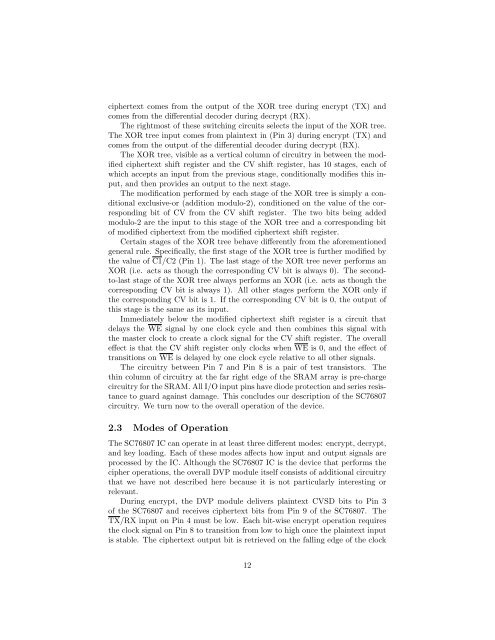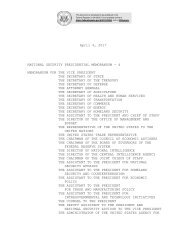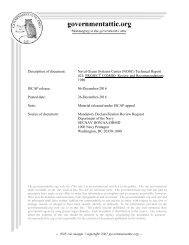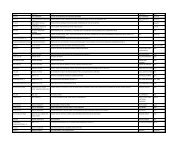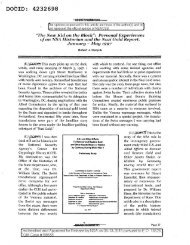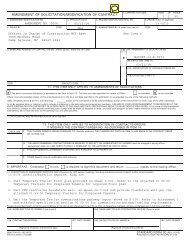vulcan-cryptanalysis
vulcan-cryptanalysis
vulcan-cryptanalysis
You also want an ePaper? Increase the reach of your titles
YUMPU automatically turns print PDFs into web optimized ePapers that Google loves.
ciphertext comes from the output of the XOR tree during encrypt (TX) and<br />
comes from the differential decoder during decrypt (RX).<br />
The rightmost of these switching circuits selects the input of the XOR tree.<br />
The XOR tree input comes from plaintext in (Pin 3) during encrypt (TX) and<br />
comes from the output of the differential decoder during decrypt (RX).<br />
The XOR tree, visible as a vertical column of circuitry in between the modified<br />
ciphertext shift register and the CV shift register, has 10 stages, each of<br />
which accepts an input from the previous stage, conditionally modifies this input,<br />
and then provides an output to the next stage.<br />
The modification performed by each stage of the XOR tree is simply a conditional<br />
exclusive-or (addition modulo-2), conditioned on the value of the corresponding<br />
bit of CV from the CV shift register. The two bits being added<br />
modulo-2 are the input to this stage of the XOR tree and a corresponding bit<br />
of modified ciphertext from the modified ciphertext shift register.<br />
Certain stages of the XOR tree behave differently from the aforementioned<br />
general rule. Specifically, the first stage of the XOR tree is further modified by<br />
the value of C1/C2 (Pin 1). The last stage of the XOR tree never performs an<br />
XOR (i.e. acts as though the corresponding CV bit is always 0). The secondto-last<br />
stage of the XOR tree always performs an XOR (i.e. acts as though the<br />
corresponding CV bit is always 1). All other stages perform the XOR only if<br />
the corresponding CV bit is 1. If the corresponding CV bit is 0, the output of<br />
this stage is the same as its input.<br />
Immediately below the modified ciphertext shift register is a circuit that<br />
delays the WE signal by one clock cycle and then combines this signal with<br />
the master clock to create a clock signal for the CV shift register. The overall<br />
effect is that the CV shift register only clocks when WE is 0, and the effect of<br />
transitions on WE is delayed by one clock cycle relative to all other signals.<br />
The circuitry between Pin 7 and Pin 8 is a pair of test transistors. The<br />
thin column of circuitry at the far right edge of the SRAM array is pre-charge<br />
circuitry for the SRAM. All I/O input pins have diode protection and series resistance<br />
to guard against damage. This concludes our description of the SC76807<br />
circuitry. We turn now to the overall operation of the device.<br />
2.3 Modes of Operation<br />
The SC76807 IC can operate in at least three different modes: encrypt, decrypt,<br />
and key loading. Each of these modes affects how input and output signals are<br />
processed by the IC. Although the SC76807 IC is the device that performs the<br />
cipher operations, the overall DVP module itself consists of additional circuitry<br />
that we have not described here because it is not particularly interesting or<br />
relevant.<br />
During encrypt, the DVP module delivers plaintext CVSD bits to Pin 3<br />
of the SC76807 and receives ciphertext bits from Pin 9 of the SC76807. The<br />
TX/RX input on Pin 4 must be low. Each bit-wise encrypt operation requires<br />
the clock signal on Pin 8 to transition from low to high once the plaintext input<br />
is stable. The ciphertext output bit is retrieved on the falling edge of the clock<br />
12


